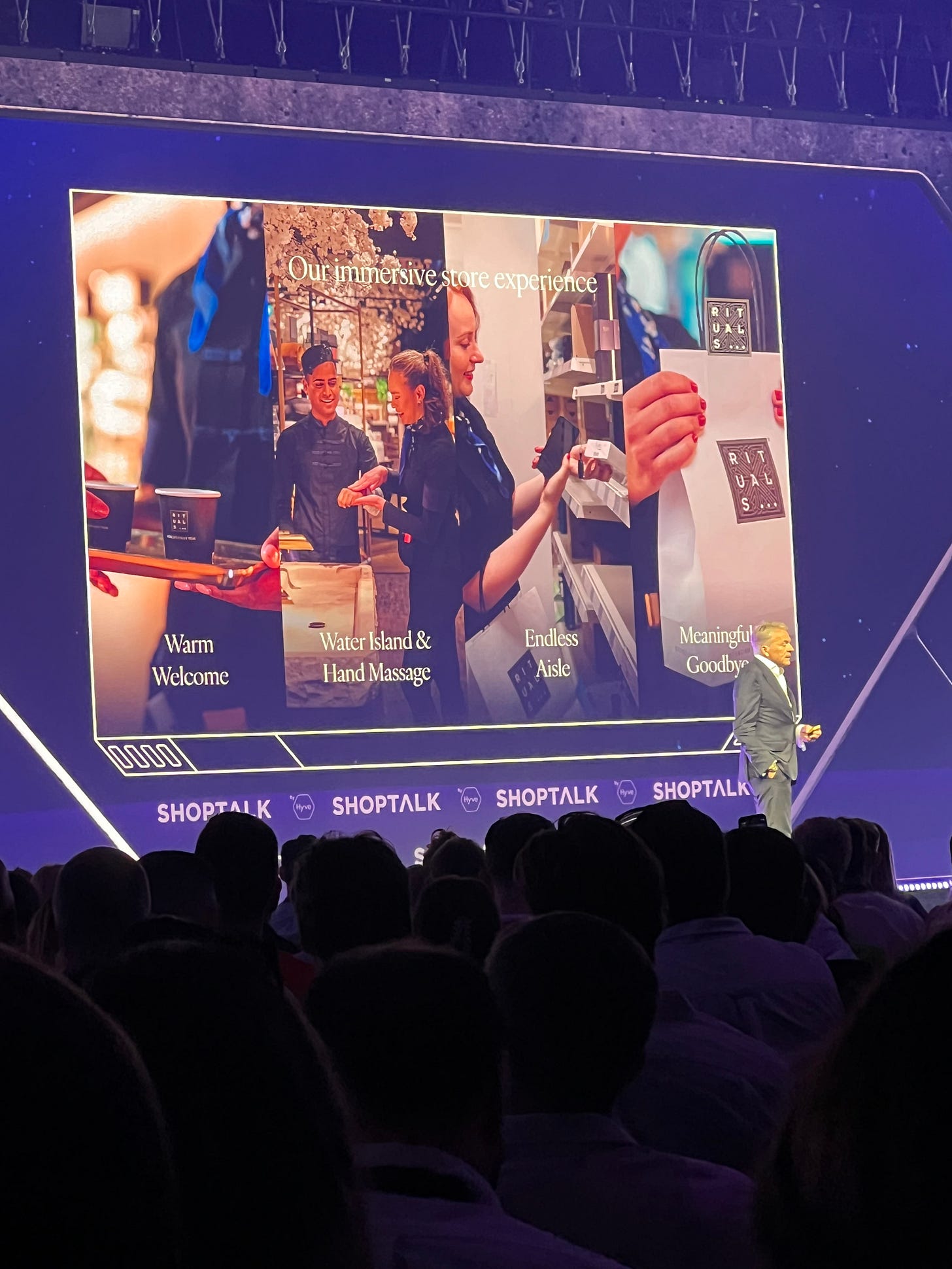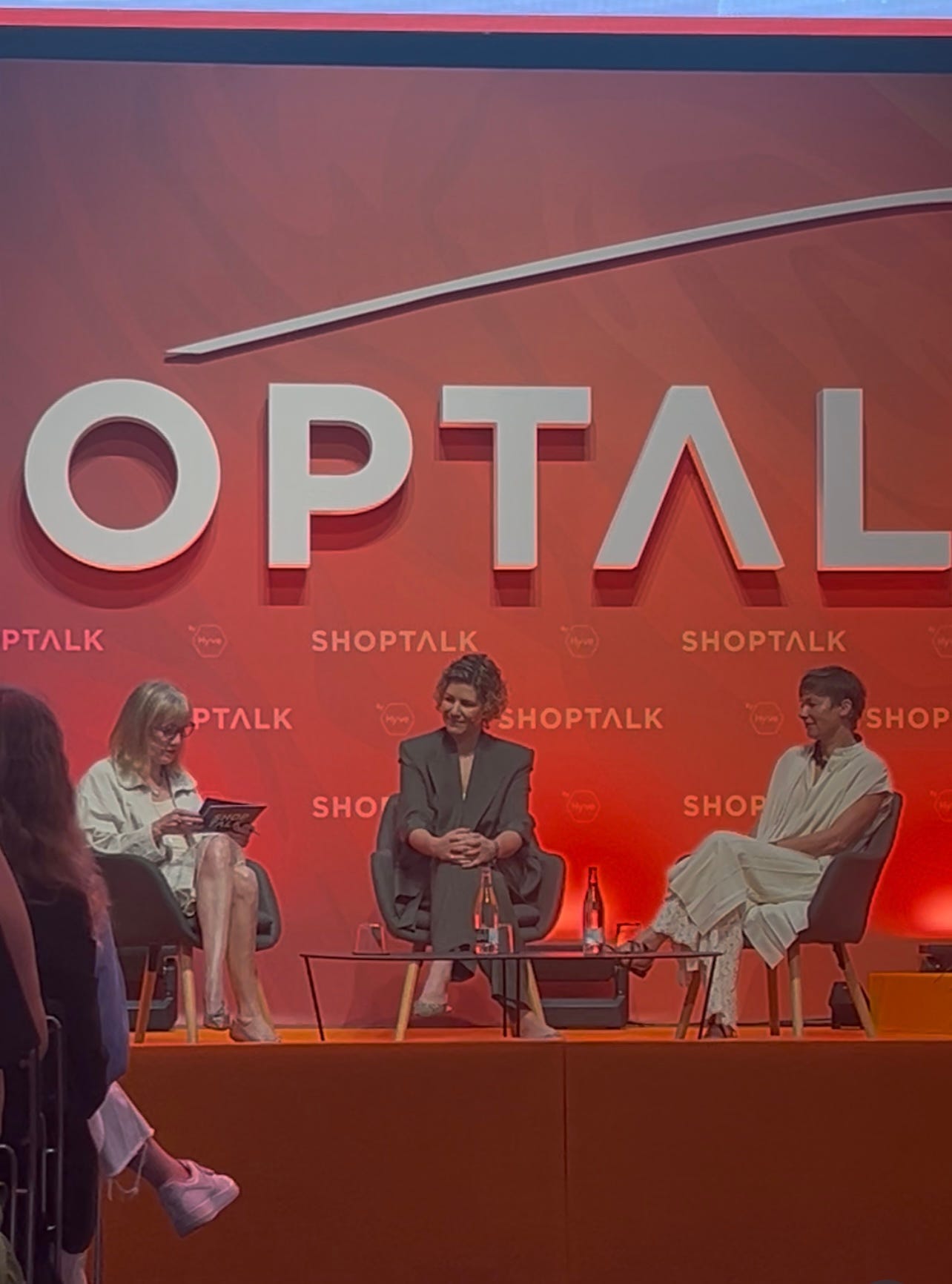ShopTalk Europe 2025 Key Insights
Executives at top brands show part of the blueprint to attaining success in a difficult market.
Last week I took a trip to Barcelona, Spain to attend ShopTalk Europe, the largest retail conference in the region. This year, roughly 4,500 retail professionals from over 70 countries around the world descended onto the city to discuss the future of retail across clothing, grocery, beauty, CPG, and more. The insights for the fashion industry were rich and brands that can capitalize on these will set themselves up for success in the short and long term.
The European consumer landscape has changed again
WSGN CEO Carla Buzasi took us through an incredibly comprehensive deck of their latest research on the consumer trends transforming retail across Europe. Divided into four sections, there were some critical points brands need to take to heart in order to peak the interest of this region’s shoppers:
Spaving - the act of spaving is spending money to save money. Consumers aren’t just chasing the lower price, they’re more thoughtful in their purchase. 32% of global consumers feel worse off financially compared to a year ago. You need to be “on the consumer’s side”. Brands should also champion slower consumption models as this is appearing to be part of the winning formula.
Cultural Currency - In 2023, 42% of people aged 15-34 in the UK lived with their parents. Over 30% of global HNWIs (High Net Worth Individuals) say branded hospitality experiences are a driver of purchases. You must deeply understand the unique situations and desires of your various customer segments.
Wellness Overwhelm - tackle wellness burnout. Don’t do gimmicks. How are you supporting your customers in your messaging and the shopping experience when they constantly deal with analysis paralysis or become overstimulated?
Vibecession Spending - creating cool, fun, memorable, and inspiring experiences. 90% of people globally feel like the number of crises has increased in recent years. The output is that consumers are seeking to numb themselves from this pain. You should also be meeting their rising interest in spirituality (NOT organized religion).
Invest in the in-store experience
Brands have greatly profited from their eCommerce motions during and post-Covid. Even though some companies might be shuttering their brick and mortar stores to cut costs, people are still shopping in person. From the start of the company, Rituals CEO Raymond Cloosterman knew he wanted to provide a luxury buying experience and he’s tied that in perfectly within their brand DNA. “We never wanted to forget to enjoy the little things in life. We didn’t want people to have routines. We wanted to give people rituals.” From the brief hand massage you get when entering any of their stores to the sessions you can book within their mind studio oasis, there’s no shortage of ways this company embodies the future of luxury in the wellbeing space. They’re on pace to clear roughly $2.5B in global sales this year.
With the mass adoption of AI tools, leadership teams might be tempted to start letting go of in-store staff for some kind of AI experience. While this might work for lower priced items, this isn’t something that will bode well for companies selling mid to high priced products. Canada Goose’s Carrie Baker has explicitly stated AI won’t be a replacement but an enhancement for its brand ambassadors (what they call their sales associates). She wants them to be deeply engaged with their customers, but this doesn’t necessarily equate to speed. The better you know who you’re interacting with on a personal level, the more you’ll be able to serve them and keep them coming back.
New loyalty programs > old loyalty programs
When you establish brand loyalty, you have the opportunity heighten customer retention. But our needs are constantly evolving and loyalty programs must evolve side by side with them. Michael Ward has been the Managing Director at Harrods for 20 years. Their loyalty program isn’t just your basic “spend X amount and we’ll give you discounts” platform. There are tiers that provide product/service exclusivity and events with each rung of the ladder. And because they have relationships with so many brands and celebrities, it’s incredibly hard to compete with. Becoming data driven and using predictive analytics helped shape their program today. “We know if people are buying luxury vs non luxury. We know what they want to eat, etc. It’s all about predictability and who we’re overlooking and not catering enough to.”
Marketing is a long game.
Yes, celebrity-led companies get tons of press, more easily lock in partnerships, and have unusually large marketing budgets for where they are in their company lifecycle. This is not the norm for the vast majority of founders and early teams. While I’m happy about Hailey Bieber’s recent exit of Rhode, brands cannot and should not bank on their ability to mimic this. Erik Lautier, a partner at consulting firm AlixPartners, says he’s seeing a trend of marketing teams getting back to basics and allocating more dollars to upper funnel activities. Marketing attribution can be hard to measure, making it difficult to justify to other c-suite executives a large investment in awareness, but this shift is crucial in order to focus on extending a customer’s Lifetime Value (LTV). Another way to increase LTV is providing a high quality product. Tina Müller, the CEO of the global beauty company Weleda, loves when her digital and social teams can capitalize on moments when celebrities use Weleda products without any prompting or influencer spend (Bella Hadid gave them a shoutout on social media because she’s loves the brand.) As you’d expect these moments trigger an enormous jump in orders and eventually sell out quickly. Tina knows they’re missing out on revenue by not having more product readily available, but they take pride in their all-natural formulas and own the full supply chain including raw materials. They would have to cut corners and diminish the product quality to meet every spikes in demand driven by social, and that’s not something they’re willing to do. These are decisions that have allowed the business to thrive for over 100 years.
International growth is a great driver of your business, but execute wisely
Marlies Hersbach is Mango’s eCommerce Executive Director. As of today, they’re in 120 markets with worldwide. Their 4E company plan is how they’ve been so successful thus far. This strategy is comprised of four elements:
Elevate - constantly ensure the brand’s attractiveness and emphasizing their value proposition
Expand - growth in their most important strategic markets globally
Earn - monetization strategies of new and existing stores
Empower - continue to develop their 15,500+ employees worldwide
They also have a state of the art distribution facility in Europe that allows them to fulfill orders at an incredibly high speed. She also mentioned the importance of understanding the markets you’re entering. Are they similar to any that you’re currently in? Is there genuine demand for your product?
From another lens, it’s also important to remember you don’t have to do it alone. Manolo’s Global Head of Digital and Customer Experience Bianca Mercer discussed how cross border partners have been so crucial to their success. When they want to enter a new market, its’ relatively easy for them to activate and have a trusted entity take care of localization of their websites, payment methods, shipping, etc. Earlier this year they entered the Chinese market and realized these customers didn’t know the iconic brand as well as they assumed. While it’s not a regular go-to-market tactic they’ve used given their recognizable name in women’s shoes, partnering with local KOLs (Key Opinion Leaders) has allowed them to begin telling the Chinese market their brand story. Flexibility and agility are clearly key attributes to successful growth abroad.




